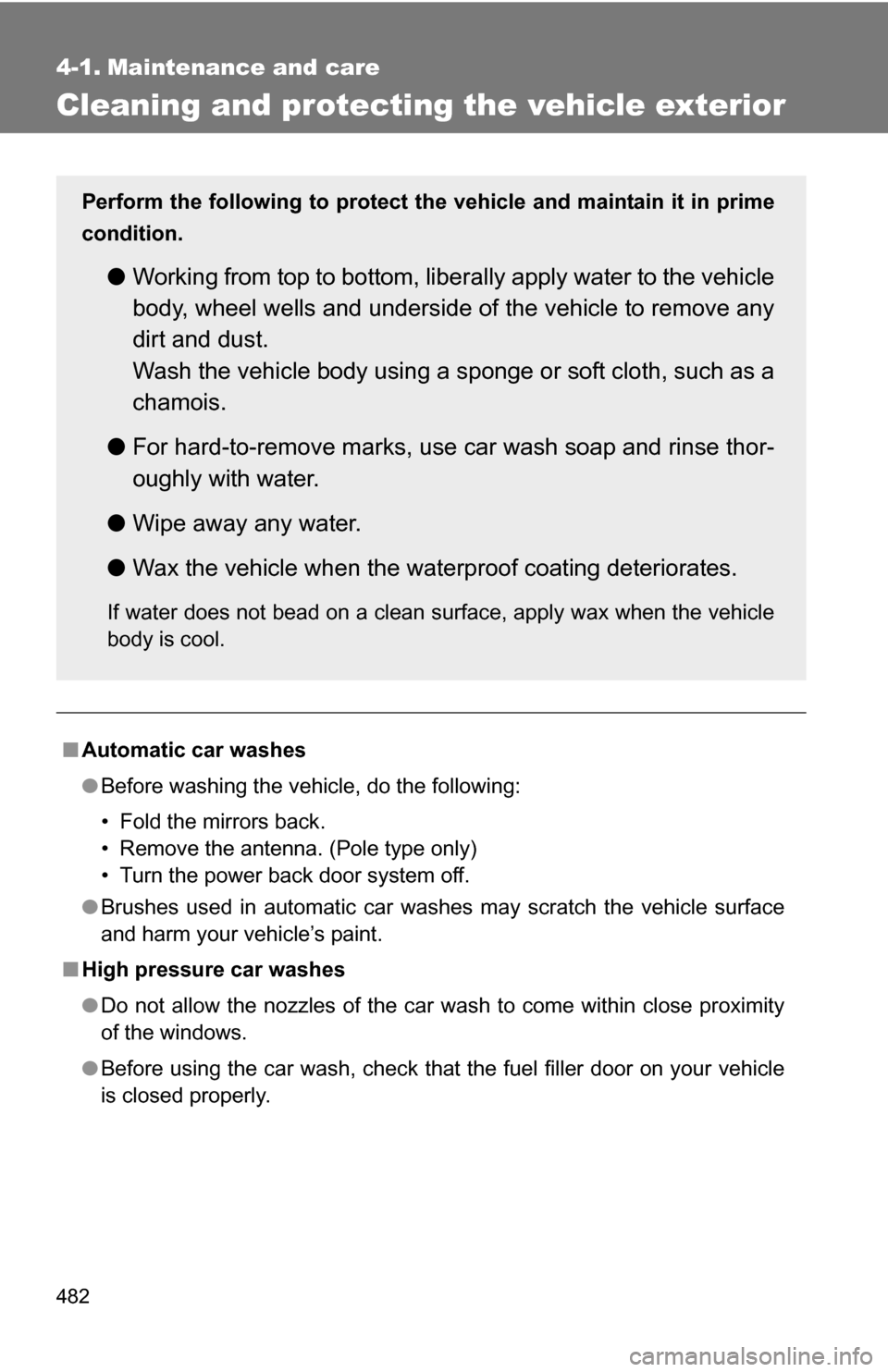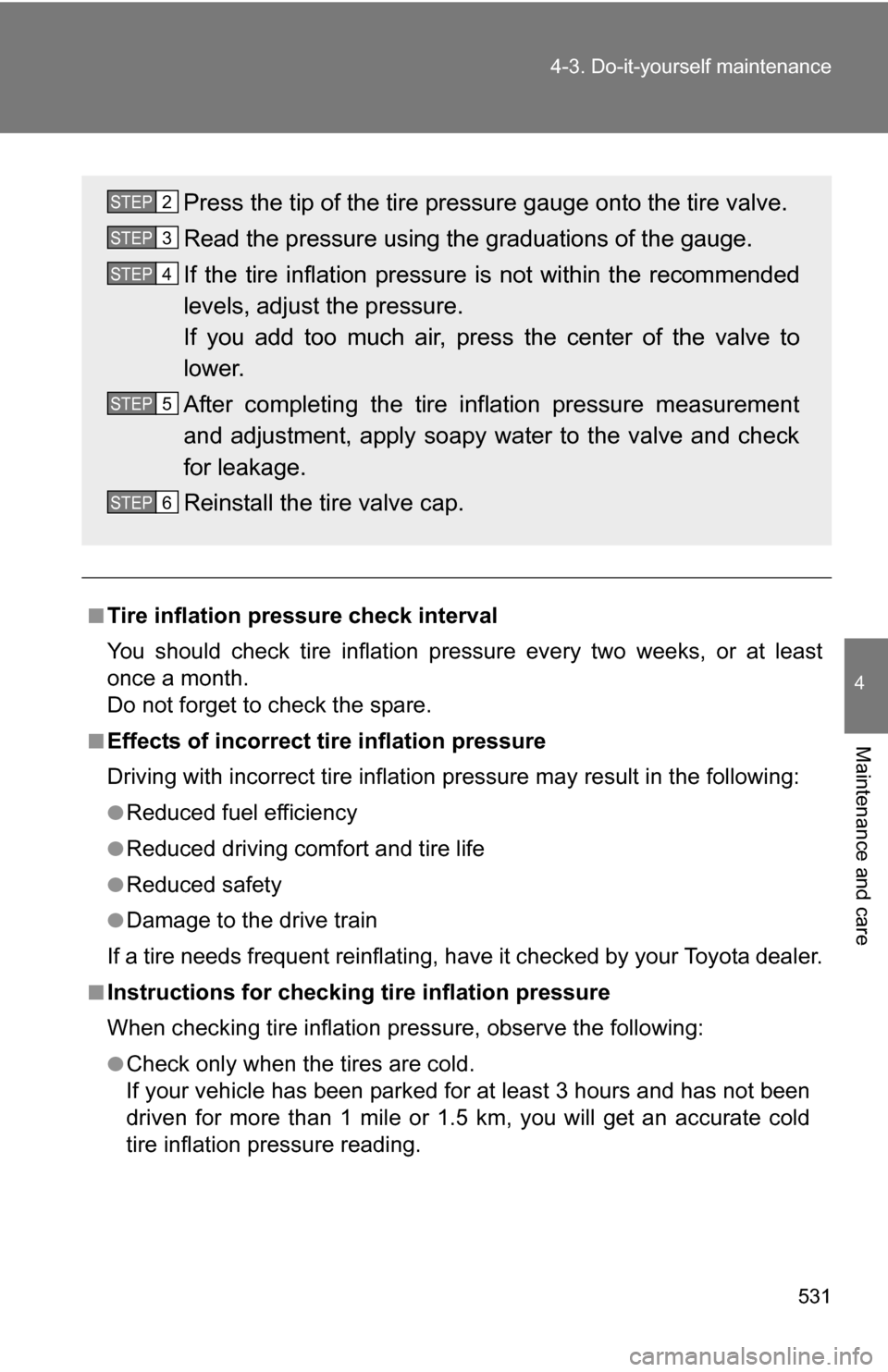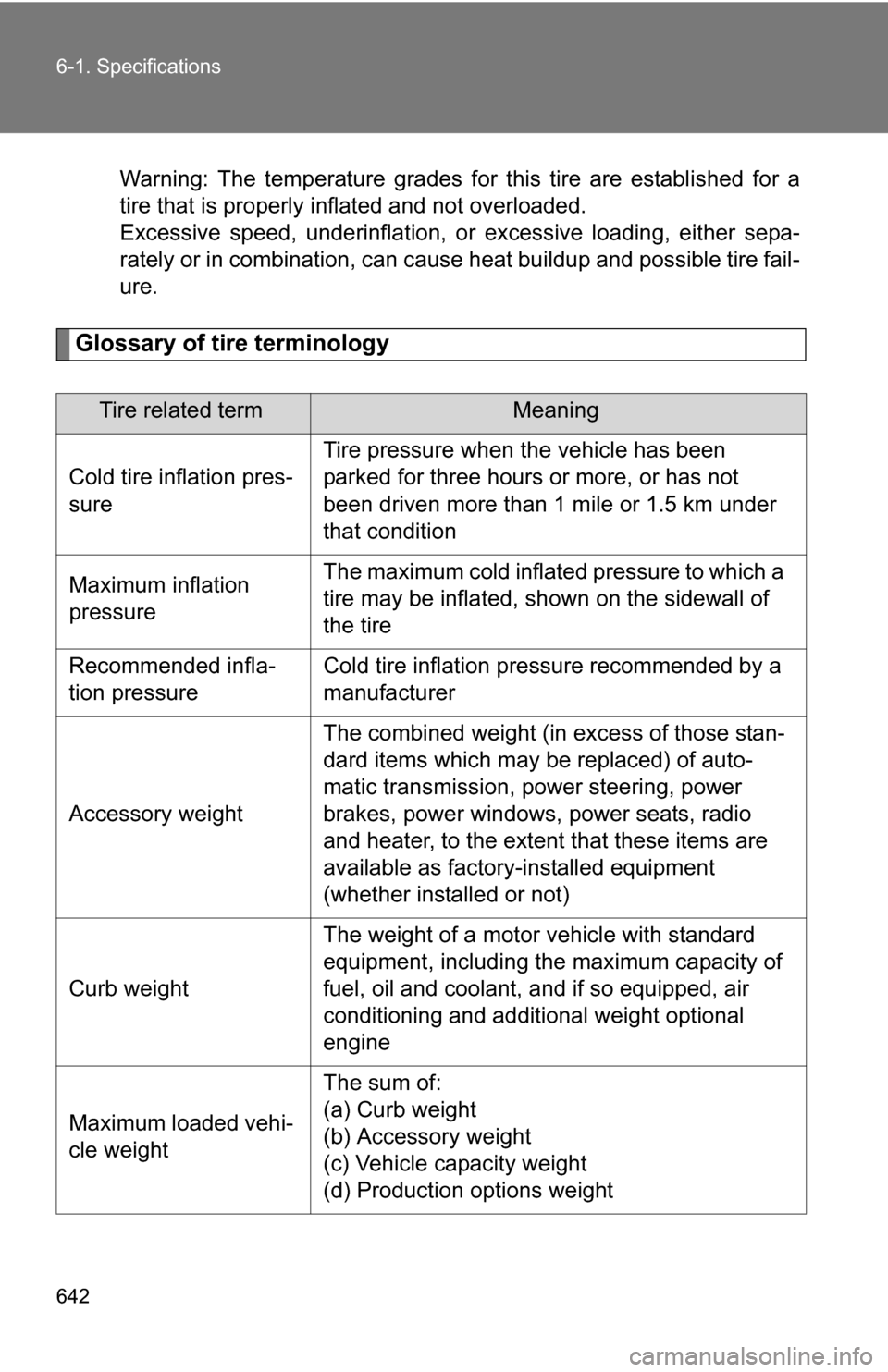2013 TOYOTA HIGHLANDER fuel pressure
[x] Cancel search: fuel pressurePage 5 of 684

1
2
3
4
5
6
7
5
4-1. Maintenance and careCleaning and protecting the vehicle exterior............ 482
Cleaning and protecting the vehicle interior............. 485
4-2. Maintenance Maintenance requirements ..................... 488
General maintenance.......... 491
Emission inspection and maintenance (I/M)
programs........................... 494
4-3. Do-it-yourself maintenance Do-it-yourself service precautions ....................... 495
Hood ................................... 499
Positioning a floor jack ........ 501
Engine compartment ........... 505
Tires .................................... 521
Tire inflation pressure ......... 530
Wheels ................................ 533
Air conditioning filter............ 536
Wireless remote control/ electronic key battery ........ 539
Checking and replacing fuses ................................. 542
Light bulbs........................... 553 5-1. Essential information
Emergency flashers............ 562
If your vehicle needs to be towed........................... 564
If you think something is wrong ............................... 571
Fuel pump shut off system .............................. 572
5-2. Steps to take in an emergency
If a warning light turns on or a warning buzzer
sounds... .......................... 573
If a warning message is displayed .......................... 584
If you have a flat tire ........... 586
If the engine will not start.... 600
If the shift lever cannot be shifted from P ................... 602
If you lose your keys/ wireless remote control
transmitter ........................ 603
If the electronic key does not operate properly ......... 604
If the battery is discharged........................ 606
If your vehicle overheats .... 610
If the vehicle becomes stuck ................................. 613
If your vehicle has to be stopped in an
emergency ....................... 615
4Maintenance and care5When trouble arises
Page 9 of 684

9
Back door P. 60
Side doors P. 54
Stop/tail and rear side
marker lights
P. 203
Rear window wiper P. 216
Rear window defogger
Glass hatch
P. 295
P. 70
Rear turn signal lights P. 183
: If equipped
*1: For vehicles with a Display Audio system, refer to the “Display Audio System Owner’s Manual”.
*2: For vehicles with a navigation system, refer to the “Navigation System Owner’s Manual”.
Tires
●Rotation
● Replacement
● Inflation pressure
● Information
P. 521
P. 586
P. 630
P. 636
Fuel filler door P. 109
License plate lights P. 203
Rear view
monitor system
camera
, *1, *2
P. 223
Page 16 of 684

16
Rear view monitor system
(vehicles without a Display Audio sys-
tem or navigation system)
Multi-information display
Clock
P. 223
P. 193
P. 196, 454
Gauges and
meters
P. 186
Tilt and telescopic steering lock release
lever
P. 94
Glove box P. 440
Pictorial indexInstrument panel
Power back door
main switch
P. 62
Tire pressure warning reset switch P. 523
Parking brake pedal P. 184
Hood release lever P. 499
Auxiliary box P. 448
Engine (ignition) switch
(vehicles with smart key system)
P. 171
Fog light switch
Headlight switch
Turn signal lever P. 210
P. 203
P. 183
Windshield wiper and
washer switch
Rear window wiper and
washer switch
P. 212
P. 216
Horn
P. 185Floor mat P. 464
Fuel filler door opener P. 109
Page 482 of 684

482
4-1. Maintenance and care
Cleaning and protecting the vehicle exterior
■Automatic car washes
●Before washing the vehicle, do the following:
• Fold the mirrors back.
• Remove the antenna. (Pole type only)
• Turn the power back door system off.
● Brushes used in automatic car washes may scratch the vehicle surface
and harm your vehicle’s paint.
■ High pressure car washes
●Do not allow the nozzles of the car wash to come within close proximity
of the windows.
● Before using the car wash, check that the fuel filler door on your vehicle
is closed properly.
Perform the following to protect the vehicle and maintain it in prime
condition.
● Working from top to bottom, liber ally apply water to the vehicle
body, wheel wells and underside of the vehicle to remove any
dirt and dust.
Wash the vehicle body using a sponge or soft cloth, such as a
chamois.
● For hard-to-remove marks, use car wash soap and rinse thor-
oughly with water.
● Wipe away any water.
● Wax the vehicle when the waterproof coating deteriorates.
If water does not bead on a clean surface, apply wax when the vehicle
body is cool.
Page 531 of 684

531
4-3. Do-it-yourself maintenance
4
Maintenance and care
■Tire inflation pressure check interval
You should check tire inflation pressure every two weeks, or at least
once a month.
Do not forget to check the spare.
■Effects of incorrect tire inflation pressure
Driving with incorrect ti
re inflation pressure ma y result in the following:
●Reduced fuel efficiency
●Reduced driving comfort and tire life
●Reduced safety
●Damage to the drive train
If a tire needs frequent reinflating, have it checked by your Toyota dealer.
■Instructions for checking tire inflation pressure
When checking tire inflation pressure, observe the following:
●Check only when the tires are cold.
If your vehicle has been parked for at least 3 hours and has not been
driven for more than 1 mile or 1.5 km, you will get an accurate cold
tire inflation pressure reading.
Press the tip of the tire pressure gauge onto the tire valve.
Read the pressure using the graduations of the gauge.
If the tire inflation pressure is not within the recommended
levels, adjust the pressure.
If you add too much air, pres s the center of the valve to
lower.
After completing the tire inflation pressure measurement
and adjustment, apply soapy water to the valve and check
for leakage.
Reinstall the tire valve cap.STEP2
STEP3
STEP4
STEP5
STEP6
Page 550 of 684

550 4-3. Do-it-yourself maintenance
9 DOOR NO.2 25 A Power windows
10 AM1 7.5 A Starting system
11 P/SEAT (PS) 30 A Power seat
12 A/C NO.1 10 A Air conditioning system
13 FUEL OPN 7.5 A No circuit
14 S/ROOF 20 A Electric moon roof
15 TAIL 15 AParking lights, tail lights, license
plate lights, fog lights, trailer lights
16 PANEL 7.5 AGlove box light, instrument panel
lights, switch illumination
17 ECU IG NO.1 10 A Multiplex communication system,
electric moon roof, electronically
controlled automatic transmission
system, power back door, seat
heaters, tire pressure warning sys-
tem, electric power steering, anti-
glare inside rear view mirror, shift
lock system, tire pressure warning
system
18 ECU IG NO.2 7.5 A Vehicle stability control system
19 A/C NO.2 10 A Air conditioning system
20 WASH 20 AWindshield and rear window
washer
21 S-HTR 20 A Seat heaters
22 GAUGE NO.1 10 A Audio system, back-up lights,
charging system, emergency flash-
ers, traction control system, wind-
shield wiper de-icer, air
conditioning system, charging sys-
tem, rear view monitor system,
trailer lights, multiport fuel injection
system/sequential multiport fuel
injection system
FuseAmpereCircuit
Page 582 of 684

582 5-2. Steps to take in an emergency
CAUTION
■If the tire pressure warning light comes on
Be sure to observe the following precautions. Failure to do so could
cause loss of vehicle control and re sult in death or serious injury.
●Stop your vehicle in a safe place as soon as possible. Adjust the tire
inflation pressure immediately.
●If the tire pressure warning light comes on even after tire inflation pres-
sure adjustment, it is pr obable that you have a flat tire. Check the tires.
If the tire is flat, change to the spare tire and have the flat tire repaired
by the nearest Toyota dealer.
●Avoid abrupt maneuvering and braking. If the vehicle tires deteriorate,
you could lose control of the steering wheel or the brakes.
■If a blowout or sudden air leakage should occur
The tire pressure warning syste m may not activate immediately.
■Maintenance of the tires
Each tire, including the spare (if provided), should be checked monthly
when cold and inflated to the inflation pressure recommended by the
vehicle manufacturer on the vehicle placard or tire inflation pressure
label (tire and load information label). (If your vehicle has tires of a differ-
ent size than the size indicated on the vehicle placard or tire inflation
pressure label [tire and load information label], you should determine the
proper tire inflation pr essure for those tires.)
As an added safety feature, your vehicle has been equipped with a tire
pressure monitoring system (TPMS-ti re pressure warning system) that
illuminates a low tire pressure telltal e (tire pressure warning light) when
one or more of your tires is significantly under-inflated. Accordingly,
when the low tire pressu re telltale (tire pressure warning light) illumi-
nates, you should stop and check your tires as soon as possible, and
inflate them to the proper pressure. Driving on a significantly under-
inflated tire causes the tire to overheat and can lead to tire failure.
Under-inflation also reduces fuel effi ciency and tire tread life, and may
affect the vehicle's hand ling and stopping ability.
Page 642 of 684

642 6-1. Specifications
Warning: The temperature grades for this tire are established for a
tire that is properly inflated and not overloaded.
Excessive speed, underinflation, or excessive loading, either sepa-
rately or in combination, can cause heat buildup and possible tire fail-
ure.
Glossary of tire terminology
Tire related termMeaning
Cold tire inflation pres-
sure Tire pressure when the vehicle has been
parked for three hours or more, or has not
been driven more than 1 mile or 1.5 km under
that condition
Maximum inflation
pressure The maximum cold inflated
pressure to which a
tire may be inflated, s hown on the sidewall of
the tire
Recommended infla-
tion pressure Cold tire inflation pressure recommended by a
manufacturer
Accessory weight The combined weight (in excess of those stan-
dard items which may be replaced) of auto-
matic transmission, power steering, power
brakes, power windows, power seats, radio
and heater, to the extent that these items are
available as factory-installed equipment
(whether installed or not)
Curb weight The weight of a motor vehicle with standard
equipment, including the maximum capacity of
fuel, oil and coolant, and if so equipped, air
conditioning and additional weight optional
engine
Maximum loaded vehi-
cle weight The sum of:
(a) Curb weight
(b) Accessory weight
(c) Vehicle capacity weight
(d) Production options weight